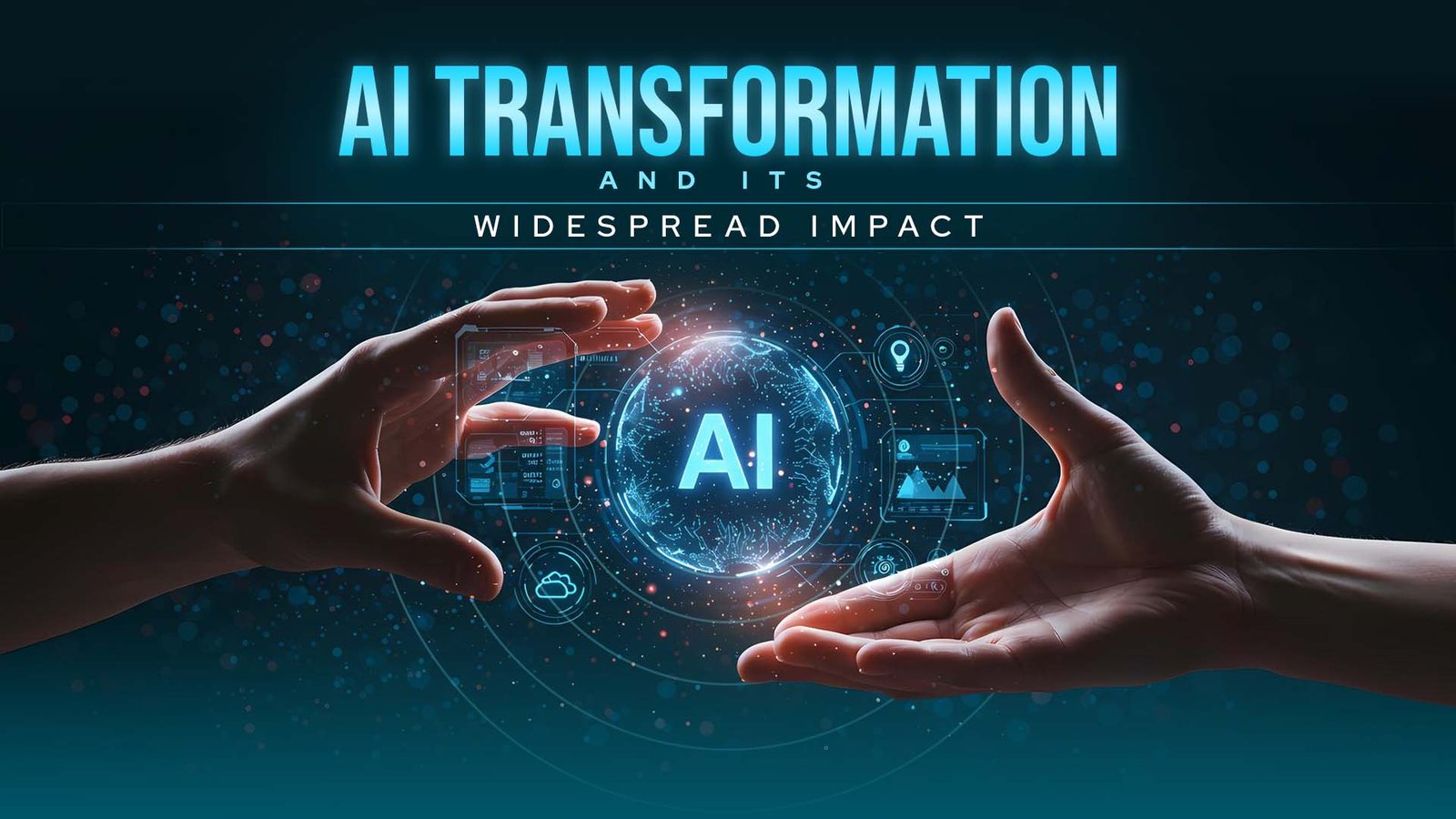- Admin
- August 2nd, 2025
- 7 min Read
AI Transformation and Its Widespread Impact
1. What Is the AI Transformation?
AI transformation refers to the sweeping integration of artificial intelligence technologies into business processes, workflows, governance, and culture—not just technology stacks. According to McKinsey’s 2025 State of AI survey, only 1% of organizations have achieved full operational maturity, though 92% plan to increase investment, and 78% already use AI in at least one business function. This transformation involves workflow redesign, role redefinition, and new governance models, not just deploying tools.
2. How Is Artificial Intelligence Transforming?
AI is transforming through multiple fronts:
- Generative AI (e.g. ChatGPT‑style models) automates content creation.
- Agentic AI (emerging in 2025) acts as virtual coworkers, autonomously planning multistep workflows
- Applied and industrial AI embed into manufacturing, healthcare, logistics, and beyond Organizations driving these shifts are moving beyond pilot projects to embed AI into value-generating core operations.
3. What Is the AI Transformation Methodology?
A mature methodology involves:
- Clarifying goals —defining business outcomes AI should drive
- Creating governance models and ethical oversight (e.g. centralized risk/compliance hubs).
- Redesigning workflows —not bolt on AI, but rewire tasks and decision-making flows.
- Hybrid talent strategy —centralizing AI strategy while distributing technical and adoption roles across business units
- Continuous upskilling —embracing both technical and complementary human skills like ethics, critical thinking, teamwork
4. How Is AI Transforming the Way We Work?
Workplace Shifts
- In a 2024 survey, employees are three times more likely than managers to believe AI will replace 30% of their tasks within a year, showing employee readiness exceeds leadership expectations
- McKinsey expects 12 million additional occupational transitions by 2030, mostly out of customer service, sales, and office support into roles with stronger human‑AI collaboration
- Generative AI tools now affect up to 50% of job tasks across industries, with 80% of US workers experiencing at least 10% task impact, and nearly 19% facing more than 50%
Skill Evolution
- AI is raising demand for AI‑complementary skills—digital fluency, ethics, teamwork, resilience—wage premiums on these have risen sharply
- Employers are increasingly adopting skill‑based hiring over degree requirements for AI roles—between 2018–2024, demand for AI skills rose 21%, while university requirements declined 15%; AI skills now command a 23% wage premium.
5. How Is AI Transforming Daily Life?
On the personal front, AI is increasingly embedded in daily habits:
- Virtual assistants (voice and text) help automate reminders, emails, scheduling.
- Personalized recommendations—shopping, news, health diagnostics—are powered by machine learning.
- Healthcare: AI‑based diagnostic tools, predictive analytics, and remote medicine are improving care and early detection.
- Transportation: rideshare routing apps, autonomous vehicle research, predictive maintenance optimization.
Consumer AI is quietly reshaping routines, often without being labeled “AI,” offering efficiency, personalization, and real‑time decision support.
6. How Many Jobs Will AI Replace by 2030?
Displacement and Creation
- The World Economic Forum’s Future of Jobs Report 2025 indicates 92 million roles will be displaced, but 110 million new roles will be created, resulting in a net gain of 78 million jobs globally by 2030
- A Goldman Sachs estimate predicts up to 300 million jobs globally could be replaced by AI by 2030 (~18% of employment)
- The WEF also projects between 85 million jobs displaced and 97 million created, signaling both disruption and new opportunity
Role‑specific Risk & Adaptability
- Microsoft Research identified 40 jobs most susceptible to AI automation, such as translators, content writers, customer-service reps, data analysts; and 40 relatively safe roles, including caregivers, plumbers, healthcare aides
- Executives like Anthropic’s Dario Amodei warn up to 50% of entry‑level white‑collar jobs may disappear in the next 1–5 years, potentially pushing unemployment sharply without proper adaptation
7. Sector-by-Sector Change: AI’s Reach
| Sector | AI Effects and Opportunities |
|---|---|
| Healthcare | Accelerated R&D (up to $560 billion/year value), AI‑designed proteins, predictive diagnostics |
| Marketing & SEO | Generative campaigns, automated content creation, real‑time customer insights, SEO optimization with AI analysis. |
| Graphics & Design | Tools like image‑generation (DALL·E, Midjourney) enable rapid ideation, localization, and prototyping. |
| Education | Personalized learning, automation of administrative tasks, AI tutors. |
| Finance | Automated reporting, risk management, fraud detection, robo‑advisors. |
| Global Industries | Manufacturing automation shifting value chains toward high-skill roles; countries gaining via AI‑driven GVC upgrades. |
| Software & IT | AI tools like Copilot automate routine coding tasks; programmers focus on creative problem-solving; routine coding error rates reduced ~40%. |
8. Effects of AI: Challenges and Opportunities
Benefits
- Efficiency and productivity: AI saves an estimated 300 billion worker-hours annually
- Economic growth: AI could add trillions—IDC forecasts $19.9 trillion into the global economy by 2030, and AI’s GDP contribution around 3.5% by then. McKinsey reports $560 billion/year R&D lift.
- New job ecosystems: Growing fields include AI engineers, data scientists, ethics managers, AI trainers/annotators, human-AI coordinators.
Challenges
- Job insecurity and stress: Surveys show 71% of US employees worry about AI’s impact; 75% fear job obsolescence.
- Uneven adoption: Only ~1% of firms are AI-mature; many struggle with leadership, governance, and integration.
- Skill mismatch: Millions may require reskilling—and human-centric abilities will matter more than ever .



